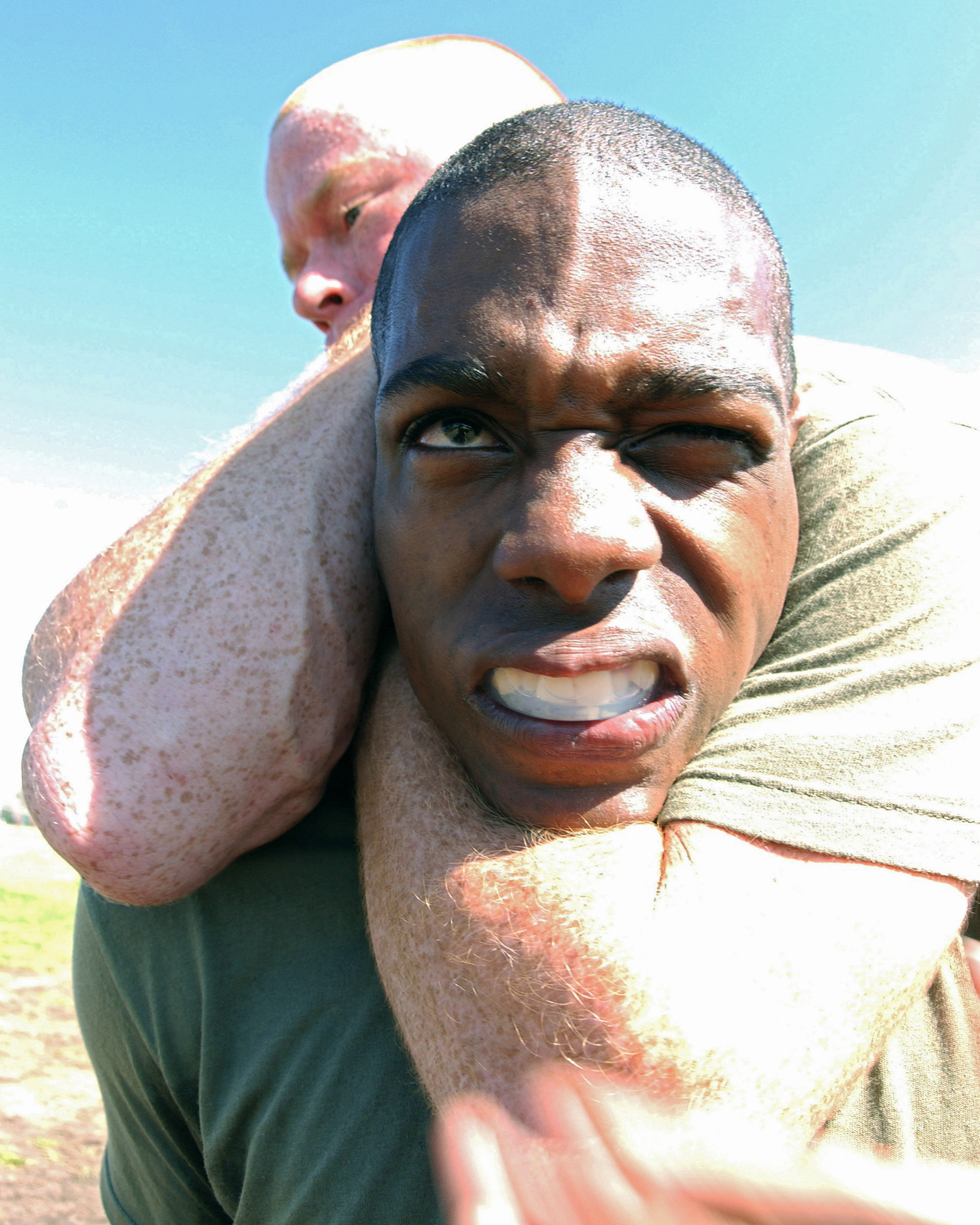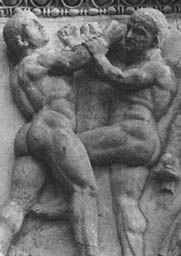|
Choke-out
A choke-out is a hand-to-hand combat tactic involving the use of a chokehold to cause syncope, or temporary loss of consciousness, at which point the choke is released. Common chokeholds in grappling used to accomplish a choke-out include the rear naked choke, arm triangle, triangle choke, and the guillotine. The mechanism can be explained as resulting from directly constraining blood flow to the brain through constriction of the carotid arteries. An additional mechanism involves compression of the baroreceptors of the carotid arteries, confusing the body into thinking blood pressure has risen. Due to the baroreflex, this inhibits sympathetic vasomotor and cardiac stimulation and increases parasympathetic stimulation of the heart causing vasodilation and a lowered heart rate. This causes a dramatic decrease in blood flow especially to regions above the heart (e.g. the brain) due the need of a high pressure to flow against gravity which in turn results in less blood flow to the br ... [...More Info...] [...Related Items...] OR: [Wikipedia] [Google] [Baidu] |
Rear Naked Choke
The rear naked choke (RNC) is a chokehold in martial arts applied from an opponent's back. The word "naked" in this context suggests that, unlike other strangulation techniques found in jujutsu/judo, this hold does not require the use of a keikogi ("gi") or training uniform. The choke has two variations: in one version, the attacker's arm encircles the opponent's neck and then grabs their own biceps on the other arm (see below for details); in the second version, the attacker clasps their hands together instead after encircling the opponent's neck. Recent studies have shown that the rear-naked choke takes an average of 8.9 seconds to render an opponent unconscious regardless of the grip that is used. "Figure four" or "short" variation This variant is considered to be a "'' blood choke''" because it restricts blood flow to the brain via the carotid arteries. When applied correctly, it can cause temporary unconsciousness in a few seconds. The following is a description of this te ... [...More Info...] [...Related Items...] OR: [Wikipedia] [Google] [Baidu] |
Hand-to-hand Combat
Hand-to-hand combat (sometimes abbreviated as HTH or H2H) is a physical confrontation between two or more persons at short range ( grappling distance or within the physical reach of a handheld weapon) that does not involve the use of weapons.Hunsicker, A., ''Advanced Skills in Executive Protection'', Boca Raton FL: Universal Publishers, , , p. 51 The phrase "hand-to-hand" sometimes include use of melee weapons such as knives, swords, clubs, spears, axes, or improvised weapons such as entrenching tools. While the term "hand-to-hand combat" originally referred principally to engagements by combatants on the battlefield, it can also refer to any personal physical engagement by two or more people, including law enforcement officers, civilians, and criminals. Combat within close quarters, to a range just beyond grappling distance, is commonly termed close combat or close-quarters combat. It may include lethal and non-lethal weapons and methods depending upon the restric ... [...More Info...] [...Related Items...] OR: [Wikipedia] [Google] [Baidu] |
Spasm
A spasm is a sudden involuntary contraction of a muscle, a group of muscles, or a hollow organ such as the bladder. A spasmodic muscle contraction may be caused by many medical conditions, including dystonia. Most commonly, it is a muscle cramp which is accompanied by a sudden burst of pain. A muscle cramp is usually harmless and ceases after a few minutes. It is typically caused by ion imbalance or muscle overload. There are other causes of involuntary muscle contractions, and some of these may cause a health problem. Description and causes Various kinds of involuntary muscle activity may be referred to as a "spasm". A spasm may be a muscle contraction caused by abnormal nerve stimulation or by abnormal activity of the muscle itself. A spasm may lead to muscle strains or tears in tendons and ligaments if the force of the spasm exceeds the tensile strength of the underlying connective tissue. This can occur with a particularly strong spasm or with weakened connective ... [...More Info...] [...Related Items...] OR: [Wikipedia] [Google] [Baidu] |
American Neurological Association
The American Neurological Association (ANA) is a professional society of academic neurologists and neuroscientists devoted to advancing the goals of academic neurology; to training and educating neurologists and other physicians in the neurologic sciences; and to expanding both our understanding of diseases of the nervous system and our ability to treat them. It was founded in June 1875. See also * American Medical Association * American Psychiatric Association The American Psychiatric Association (APA) is the main professional organization of psychiatrists and trainee psychiatrists in the United States, and the largest psychiatric organization in the world. It has more than 37,000 members are invol ... * Transactions of the American Neurological Association * Sarah McNutt References External links * Medical associations based in the United States Neurology organizations Organizations established in 1875 Medical and health organizations based in New Jers ... [...More Info...] [...Related Items...] OR: [Wikipedia] [Google] [Baidu] |
Judo
is an unarmed modern Japanese martial art, Olympic sport (since 1964), and the most prominent form of jacket wrestling competed internationally.『日本大百科全書』電子版【柔道】(CD-ROM version of Encyclopedia Nipponica, "Judo"). Judo was created in 1882 by Kanō Jigorō () as an eclectic martial art, distinguishing itself from its predecessors (primarily Tenjin Shinyo-ryu jujutsu and Kitō-ryū jujutsu) due to an emphasis on " randori" (, lit. 'free sparring') instead of "kata" (pre-arranged forms) alongside its removal of striking and weapon training elements. Judo rose to prominence for its dominance over established jujutsu schools in tournaments hosted by the Tokyo Metropolitan Police Department (警視庁武術大会, ''Keishicho Bujutsu Taikai''), resulting in its adoption as the department's primary martial art. A judo practitioner is called a , and the judo uniform is called . The objective of competitive judo is to throw an opponent, immobilize them ... [...More Info...] [...Related Items...] OR: [Wikipedia] [Google] [Baidu] |
Asystole Asystole (New Latin, from Greek privative a "not, without" + ''systolē'' "contraction") is the absence of ventricular contractions in the context of a lethal heart arrhythmia (in contrast to an induced asystole on a cooled patient on a heart-lung machine and general anesthesia during surgery necessitating stopping the heart). Asystole is the most serious form of cardiac arrest and is usually irreversible. Also referred to as cardiac flatline, asystole is the state of total cessation of electrical activity from the heart, which means no tissue contraction from the heart muscle and therefore no blood flow to the rest of the body. Asystole should not be confused with very brief pauses in the heart's electrical activity—even |



